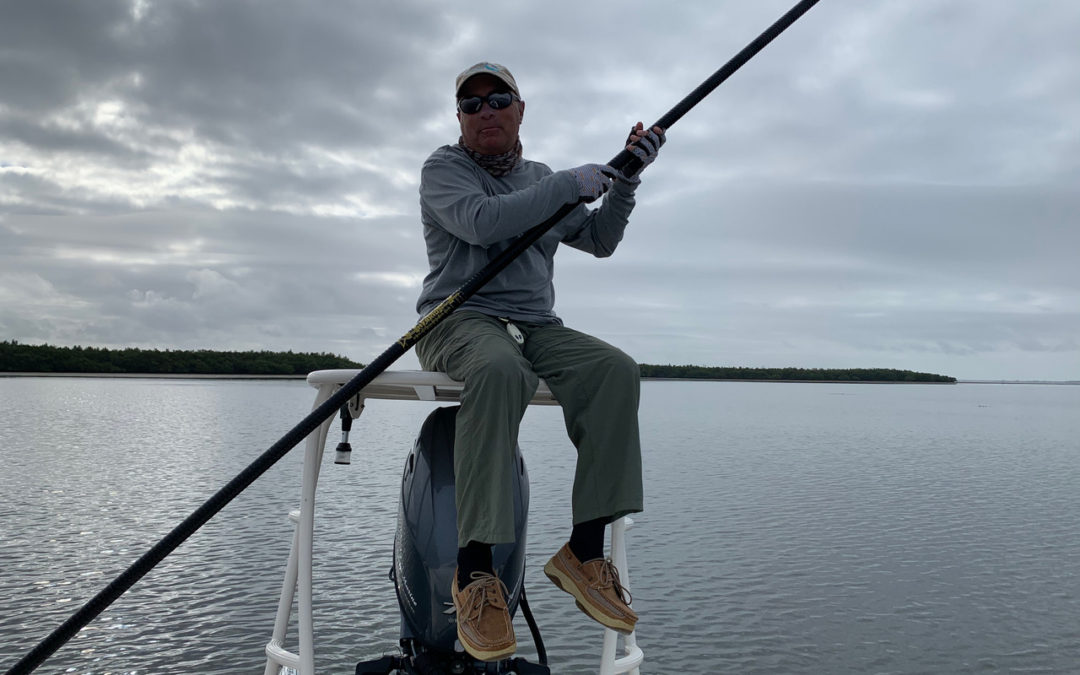So, you have finally made the decision to get that push pole. Well, you are not alone. On a weekly basis, I see quite a few anglers shopping for push poles. Generally, they have lots of questions regarding what is available at what price. There are however several issues that most of them have not had time to consider, and unfortunately won’t until they get on the platform to learn from good old trial and error. At this point, they may have wished they made a different choice. So, I thought I would try to lend a hand by offering a few pointers to maybe help make the decision a little easier. That anglers are looking at push poles doesn’t surprise me. One good look at a chart indicates just how shallow the inshore flats are around the charlotte harbor area. And hopefully, it is also an indication that as more people fish the waters adjacent to the harbor that they will consider poling instead of running over the grass. Plus, hopefully some advice will help insure that their initial experience will be as successful as possible.
To begin with, based on just how much time you plan to spend poling, combined with the size, or length and weight of your vessel, will help determine the most practical push pole to invest in. Actually, push poles are available in lengths from 5 to 21 feet. However, for most applications, lengths from 18 to 21 feet will work best for the majority of inshore anglers. Additionally, poles can be manufactured either from fiberglass, a fiberglass and graphite mixture, or 100% graphite in a couple of different modulus composites. And also, if storage is an issue, poles come in both one and two piece units. The two piece unit provides for convenient storage in a rod locker when the pole is not needed. The graphite poles are much lighter than their fiberglass counterparts, and of course, are much more expensive. For example, a typical 18 foot fiberglass pole runs about $215.00 and the same length graphite/fiberglass mixture will cost approximately $525.00. Moreover, the higher modulus pure graphite poles will run you upwards of around $800.00.
To provide an idea of weight comparison, a typical18’ fiberglass pole weighs 6.7 oz. per foot, the graphite/fiberglass composite weighs 3.6 oz. per foot, and the higher modulus 100% graphite comes in at only 2 oz. per foot. Similar to fishing rods, the lighter higher composite graphite poles are easier to break than the heavier more flexible fiberglass models. And keep in mind, graphite is a very good conductor of electricity. When thunderstorms and lightning are prevalent, you are not going to want an extended graphite pole up in the air.
With all this in mind, think about just how you intend to utilize your push pole. In other words, how much time do you anticipate spending on the poling platform? If you plan to use only occasionally, for example, to help get out of some extremely shallow situations, or solely to get you close enough to wade, then the heavier fiberglass pole will be sufficient.
However, if you plan to put some time in on the platform in order to sight fish, or just quietly work around the potholes of a shallow flat or mangrove shoreline for more than an hour or two per trip, then the lighter weight of the graphite composites will provide a tremendous advantage.
The length will be your next consideration and it’s better to be longer than too short. In my opinion, if your boat is 18’ in length or less, go with a 20’pole, and if you are trying to pole a flats boat bigger than 20’, go with a 21’ pole. This reasoning is based on proper technique. By far, the most efficient way to pole your boat is by pushing down with a hand over hand method. This will basically let you walk your way down the pole. This is where the extra length comes in handy. The longer you can work hand over hand without having to pick the pole up again works to your advantage. This is also where the lighter weight helps out. Picking up a 9 lb. (21 foot fiberglass pole), compared to a 4.75 lb. (21 foot graphite/fiberglass composite), throughout a day makes a big difference. Next week, I will get more into some of the specific fundamentals and methods related to the actual art of poling itself.
As a final point, all poles come with two different ends, a tip and a foot. On softer bottom cover, the foot is very effective for pushing against the ground, and the tip can actually be used to stake out the boat. This is actually a technique for quick anchoring. On firmer ground, the tip is a good tool for pushing off the bottom, and in this case you can actually use the foot as a handle for additional grip.


Recent Comments